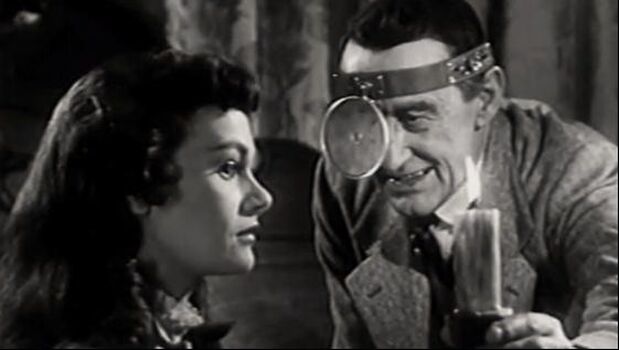[Tearing Through Werewolf Cinema] 'The Daughter of Dr. Jekyll' Threw Classic Monsters Into a Blender9/16/2020  Welcome to a weekly series in which Doris V. Sutherland takes readers on a trip through the history of werewolf cinema... ...Created by director Edgar G. Ulmer and writer-producer Jack Pollexfen, Daughter of Dr. Jekyll (1957) opens with a narrator telling us about the film’s literary inspiration: “One of the early masterpieces of science and horror is Robert Louis Stevenson’s immortal Dr. Jekyll and Mr. Hyde, the thought-provoking story of how a strange experiment transforms a benevolent doctor into Mr. Hyde, a human werewolf.” The voiceover assures us that Dr. Jekyll is no more, at which point a hairy-faced Mr. Hyde grins at the camera. “Are you sure?” he asks, before letting out a Skeletor-worthy cackle. The film’s protagonist is orphan Janet (Gloria Talbott) who returns to her family home in time for her twenty-first birthday, hoping to settle down with her fiancé George (John Agar). But she is thrown into dismay when her old guardian Dr. Lomas (Arthur Shields) reveals her true parentage: she is the daughter of Dr. Jekyll, whose body is buried beneath the very manor she is poised to inherit. The locals still live in fear of the late doctor and believe that his monstrous spirit returns to the earth with every full moon. Surrounded by such tales, Janet starts to fear that she has inherited Dr. Jekyll’s two-faced condition. George and Dr. Lomas try to persuade her that this is just her imagination, that her memories of walking about at night committing murders are no more than bad dreams—but when the victims in her nightmares start turning up dead in reality, Janet is convinced that she is a werewolf. The same year that I Was a Teenage Werewolf gave lycanthropy a hip fifties update, Daughter of Dr. Jekyll came up with a rather more backward-looking approach to its subject matter. The film plunders the old favourites from Universal and its thirties rivals and ends up throwing multiple classic monsters into a blender. Dr. Jekyll is now a werewolf—notably, the film uses the word “werewolf” more than it uses the name Mr. Hyde—and on top of that, he’s taken on some distinctly vampiric attributes. In one scene, George pores over a book entitled Witch, Warlock, and Werewolf: The werewolf is usually supposed to be the soul, sometimes of a dead body, sometimes of a human monster, which quits either the dead or the living body by night to suck the blood of living persons. Hence when the werewolf’s grave is opened, his corpse is found to be fresh and rosy from the blood which he has thus absorbed. To put a stop to its ravages, a stake is driven through the corpse, or the head cut off, or the heart torn out and the body burned. Such is the fate that befell Dr. Jekyll, we are told—quite contrary to the suicide portrayed by Stevenson. There’s a certain irony in the fact that, at a time in which the mad science lycanthropes of The Werewolf and I Was a Teenage Werewolf were in vogue, the film that returns werewolves to the mists of superstition and Gothicism is the one that is, ostensibly, about a mad scientist. Furthermore, given how unconvincing the pseudoscientific werewolves tend to be, it’s a refreshing development. With its themes of gaslighting and manipulation, Daughter of Dr. Jekyll has a lot in common with Universal’s She-Wolf of London—certainly, it’s closer in plot to that film than to anything written by Stevenson. The plot beats are easy to predict, but there’s fun to be had in seeing the exact order in which they occur. It’s also a well-directed film, which should not be a surprise considering that it was helmed by Edward G. Ulmer, the man behind (amongst many other things) Universal’s 1934 classic The Black Cat. Released at the time in which Gothic horror was being given a new lease on life by the full-colour gore of Hammer, Daughter of Dr. Jekyll likely seemed rather old-fashioned when it first came out. By steadfastly imitating the Universal model, it marked itself as a throwback to a bygone era. But looking back, it has to be said that the film actually stands up remarkably well alongside the Universal sequels it strove to match: as loose as the plot may be, the film conducts itself with total sincerity and remains a quite engaging piece of old-school monster moviemaking. By Doris V. Sutherland Enjoy Doris' writing? Leave her a tip here through Ko-fi!
0 Comments
Leave a Reply. |
Archives
March 2023
|


 RSS Feed
RSS Feed